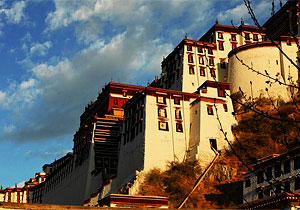Potala Palace

Potala Palace resolutely stands on the steep Marpo Ri Hill as the most recognized and visible landmark in Lhasa. It was first built by King Songtsen Gampo in 637 in order to greet his bride Princess Wen Cheng of the Tang Dynasty. And the mountain location was for better guarding against the remaining rebels' attacks during Songtsen Gampo's early unifying Tibet years. The palace had been repeatedly damaged for the nature and war reasons and then rebuilt and expanded. Today what we see is the expanded version of 17 century since when Lhasa serves as the political and religious center in Tibet.
The 13-storey Potala Palace complex, led by over 900 sharp winding stairs from the square below, consists of linked but distinct White Palace and Red Palace, both of which are named for their distinct whitewashed and crimsonwashed walls. In Tibetan Buddhism, white always signifies the kindness and peace while the crimson is applied to respect and honor the Buddhist leaders and heroes. Inside the palace, prayers murmuring, yak-mutter-smell and wafting incense cover this palace with more holy and mysterious touch.
The 9-storey White Palace on the eastern part was used for living and governing quarters of Dalai Lama. The life in the palace can be glimpsed in the luxurious apartments of the 13th and 14th Dalai Lamas. The witnesses of the administrative function like throne-consigning scripts, the gold empower fingerprints add more political touch to the overwhelming quantity of intricate paintings and carvings on the walls and beams or up in the ceiling, everywhere your eyes glance at. The roof offers you a sweeping view of the city.
The central-rising Red Palace surmounted by gilded roofs and towers was for religious purposes and contains principal halls and chapels and shrines of past Dalai Lamas. Among eye-dizzying and awe-inspiring treasure trove and religious ceremony quarters, figure statues, the most impressive wonder is the Funeral Chorten of the Fifth Dalai Lama adorned with over 3,000 kg gold and over 20 thousand pieces of jewels.
At the foot of the Potala Palace complex, there is a 3-storey exhibition hall (open: 8am-4:30pm, fee: about 10 Yuan) reformed from an old mansion displaying a limited genuine treasure collection from Potala Palace. The Potala Square reached by a fancy Tibet-style tunnel switches on its fountains (not daily) and lights around 9-12pm. The lit-up Potala with the setting of the dark sky curtain looks like a golden palace in an oil painting, completely different from the daytime hue mix of red and white and deep blue.